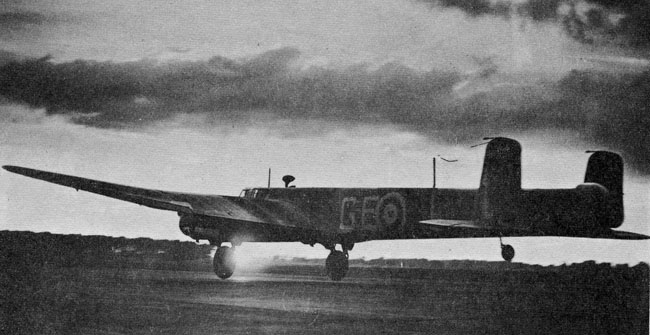A 58 Squadron Whitley landing at Linton on Ouse.
At 16.05hrs on 3rd December 1940 this 58 Squadron Whitley took off from Linton on Ouse and along with eight other Whitley's the order was to bomb a target at Lorient. The Whitleys encountered thick cloud over the target and only four aircraft managed to bomb, there were no losses over the target area. On their return to Yorkshire the pilot of this aircraft mistook the flare path at the dummy "K" Site airfield at the top of Sutton Bank near Cold Kirby for that of a real airfield. The area of Cold Kirby was enveloped in cloud, the aircraft made two unsuccessful attempts at landing and on the third he touched down a distance up the field. There was a strong tail wind at the time, it was thought this wind caused the aircraft to increase its ground speed. The landing was made at 00.10hrs but the Whitley hit a mock-up aircraft and both aircraft were wrecked. The crew of the Whitley all survived.
In 2007 I met former Dialstone resident Mr Joseph Sharp who told me that the dummy airfield at Cold Kirby was used fairly frequently by bomber aircraft to make landings in the first part of the War when the weather in the Vale of York was bad. A number of these aircraft made successful landing here and took off on the Dialstone to Sutton Bank Top road when conditions improved. The dummy field initially had wooden Whitley mock-up aircraft placed on tressle tables, these were then replaced by fake aircraft on wheels which could be towed around, the site was complete with a flare path made from oil drums and burning oil. German aircraft are not thought to have been too fooled by the decoy however. It is known that one bomb was dropped close to White Mare Crag, and did not explode. It was found by Mr John Sharp of Dialstone whilst rounding sheep up, and later removed from the ground and blown up. The result of their digging is apparently still visible. A further site was built later in the War to the north of Dialstone Farm, near where a Halifax would crash in 1945, this decoy did not have many enemy attracted to it, the site had a generator building, which the base of is thought to remain in a field boundary.
Whitley T4207 was built to contract 38599/39 by Armstrong Whitworth Ltd. at Baginton. It was allotted to 27 MU on 6th September 1940 who then received it on 18th September 1940. The aircraft was taken on charge by 58 Squadron at Linton on Ouse on 24th October 1940. Following the mishap at Cold Kirby on 3rd December 1940 Cat.W/FB damage was the damage assessment and it was struck off charge on 11th December 1940.
Pilot - Sgt Ronald Albert Gosling RAFVR (745881).
Second Pilot - P/O Jack Gordon Kerry RAFVR (84325).
Observer - Sgt Reginald Denis Kirby RAFVR (759233).
Wireless Operator - Sgt Patrick William Kenealy Crisp RAF (509318).
Air Gunner - Sgt Uff (Probably Sgt John Grange Uff RAF (654690)).

Ronald Gosling was posted to 58 Squadron on 28th August 1940. On 3rd November 1943 he received a commission to the rank of P/O on probation (emergency) (161786). He was Mentioned in Despatches on 14th January 1944 and was promoted to F/O (war subs) on 3rd May 1944. For service with 142 Squadron he was awarded the DFC, Gazetted on 17th April 1945. He was later promoted to F/Lt on 3rd November 1945.
Jack Kerry was born in Bromley, Kent in 1919, he received a commission to the rank of P/O on probation on 24th August 1940, exactly a year later he was rose to F/O. He trained at 19 OTU prior to posting to 58 Squadron on 13th October 1940. P/O Jack Kerry was awarded the DFC for service with 58 Squadron, Gazetted on 23rd December 1941, though no citation has yet been found. He was later posted from 10 OTU to 35 Squadron on 7th August 1942. He had risen to the rank of Acting S/Ldr when he was killed on Ops with 35 Squadron on 5th October 1942 when Halifax W1047, that he was piloting, crashed in France. S/Ldr Kerry DFC was twenty three years old and is buried in Lille Southern Cemetery, France.
Reginald Kirby was born in Yarmouth in 1909, nothing is known about his early life and being above average age for aircrew he must have made a career for himself prior to joining the RAFVR. He joined 58 Squadron on 30th September 1940. Following this incident on the North Yorkshire Moors Sgt Reginald Kirby returned to active service, he sadly died on 12th May 1941 and was still serving with 58 Squadron and is buried in Great Yarmouth. He was thirty two years old. He died as result of the airfield at Linton on Ouse being bombed and also killed were some twelve other airforce personnel of 58 and 35 Squadron's including Station Commanding Officer G/C Garraway OBE who was killed commanding firefighting operations.
Patrick Crisp was born in Cambridge in 1910 and married in the St.Ives area in 1941. Sgt Patrick Crisp was posted to 58 Squadron on 12th October 1940, he was awarded the DFM for service with 58 Squadron Gazetted on 31st July 1941. He later received a commission (51582) and survived the War. He remained in the RAF until 1958 and died in Somerset in 1986.
Sgt Uff's identity was probably one P/O John Grange Uff RAF 52150 (NCO 654690); if so he later served with 104 Squadron in 1942 and was awarded a DFM "for gallantry and devotion to duty in the execution of air operations." (presented on 11th May 1943). He was made a F/Lt on 11th November 1943). He died in Nottingham in 1985.